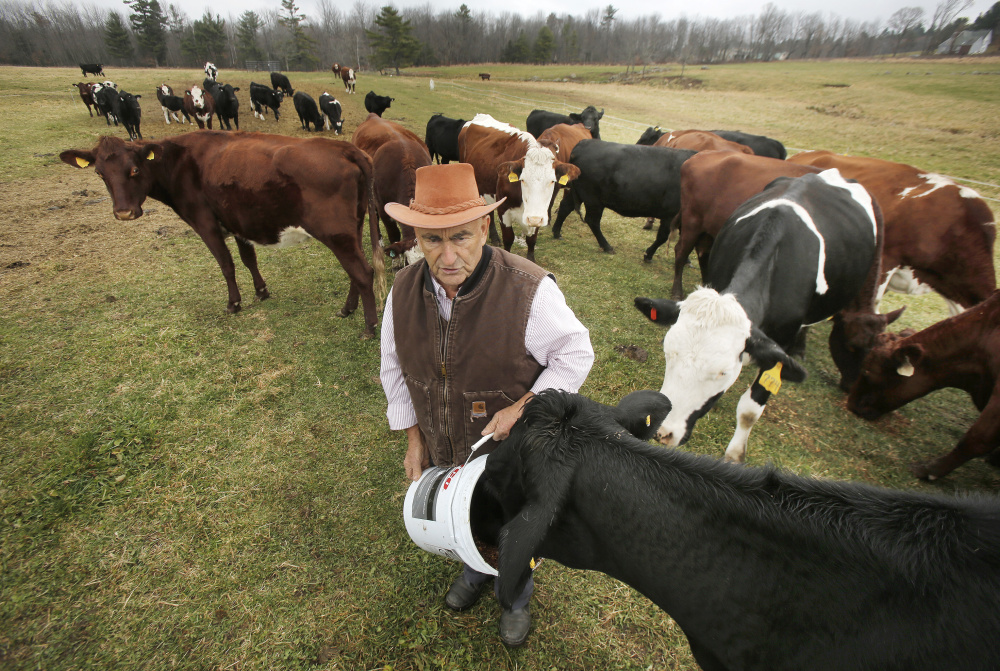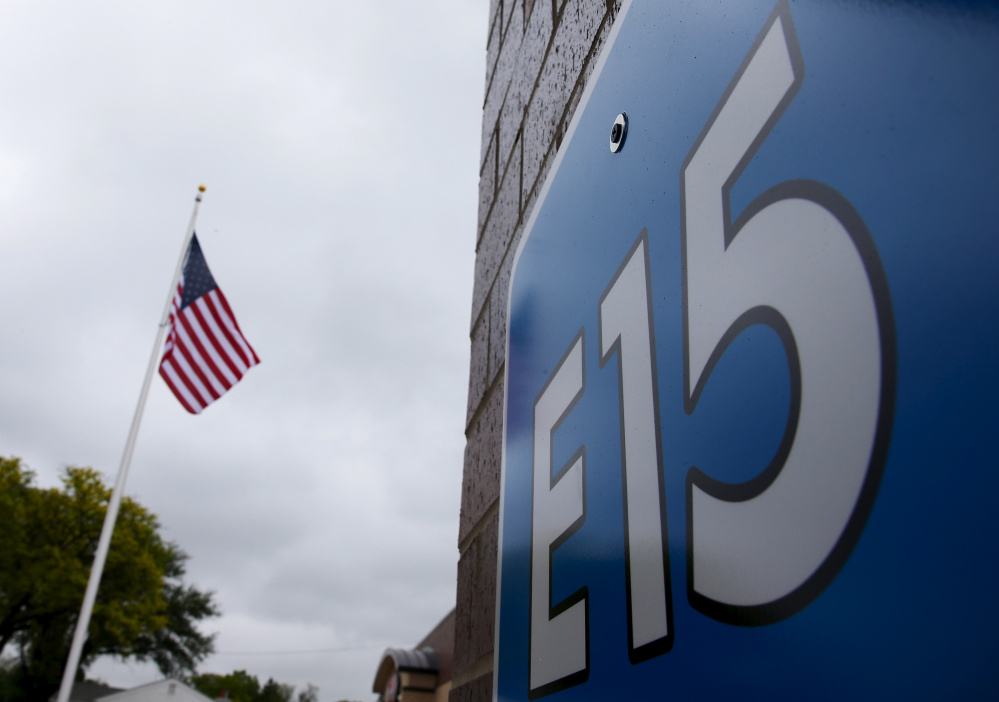The debate over the use of ethanol in gasoline is heating up again as federal regulators consider increasing the mandated amount of the corn-based biofuel used in the country’s fuel supply, a move that would worry many in Maine.
The U.S. Environmental Protection Agency has proposed revising its renewable fuel standard, or RFS, and potentially increasing the amount of ethanol mixed into traditional petroleum-based fuels. The change could affect a wide range of consumers, including:
• People who own older cars that aren’t designed to handle a higher ethanol-blend fuel.
• Owners of gas stations who would have to upgrade their facilities to accommodate a new fuel mix.
• Boat owners, snowmobile enthusiasts and other operators of small-engine equipment, who say ethanol ruins the machines.
• Maine farmers who rely on corn products to feed their livestock.
The EPA expects to make a decision Nov. 30. U.S. Sens. Angus King and Susan Collins of Maine have already announced their opposition to raising the percentage of ethanol in gasoline, and Collins, a Republican, is co-sponsoring a bipartisan bill to eliminate the corn ethanol mandate from the renewable fuel standard.
“Corn ethanol-blended gasoline poses economic and safety risks by damaging or destroying engines of older cars, boats and snowmobiles, has caused food and feed prices to rise, and presents significant environmental concerns,” Collins said, while noting that she still supports the development of advanced biofuels.
King also expressed concern.
“I have serious doubts about the use of corn-based ethanol in gasoline,” he said, “because it appears to take more energy to produce than it ultimately creates, it can damage small engines, and it can contribute to increased food prices – and it does all that without having demonstrated the environmental benefits originally promised.”
MORE TROUBLE THAN IT’S WORTH?
At the nub of the debate is whether adding the corn derivative to conventional gasoline is a net gain for the environment. Several authorities, including the National Academy of Science, say no – the negligible gains from lowering vehicle emissions don’t make up for the environmental cost of growing and processing corn for fuel, nor does the practice account for unintended consequences such as increasing the cost of livestock feed for farmers. If the U.S. production of corn isn’t sufficient to meet the demand for livestock feed and fuel additives – such as when there’s a drought – the government gives priority to RFS.
Congress created the renewable fuel standard in 2005, and expanded it in 2007, to reduce greenhouse gas emissions and the country’s reliance on foreign oil. It includes a mandate requiring ever-increasing amounts of renewable fuels, such as ethanol, biodiesel and other advanced biofuels through at least 2022. Nearly all of the roughly 138 billion gallons of gasoline used in the U.S. for transportation contains 10 percent ethanol, known as E10, according to the EPA.
Now the EPA is considering whether to increase the amount of ethanol mixed into the traditional fuel supply from 11.62 billion gallons in 2014 to 12.2 billion gallons by 2016. Although the EPA has not indicated it will do this, the worry is that the mandate will result in the percentage of ethanol increasing to 15 percent, or E15. The EPA has said the extra ethanol could be absorbed by increased sales of a higher-blend gasoline, known as E85, that is used in flex-fuel vehicles.
It’s the E15 mix that worries Jamie Py, president of the Maine Energy Marketers Association. From the perspective of his members, introducing E15 would cause major problems, including costly upgrades to stations to handle the new grade of gas.
“Everybody is a little wary of where it will go if (the blend) goes above 10 percent,” he said.
U.S. Reps. Chellie Pingree and Bruce Poliquin of Maine last week joined a group of lawmakers in sending a letter to EPA Administrator Gina McCarthy to voice their concern that the federal agency’s proposal would cause the E10 “blendwall” to be breached, meaning gasoline would move toward becoming E15.
Pingree said she worries that increasing the ethanol will create problems for Mainers who own cars and other equipment that don’t run properly on higher-blend fuels. Higher concentrations of ethanol in gas cause small engines to gum up.
“I’m not ready to say we should do away with the RFS entirely – a renewable fuel standard is not a bad idea,” she said. “But the way the current RFS is written with its reliance on corn-based ethanol and the impact it has on small engines is a real problem.”
EFFECTS ON AGRICULTURE, ENGINES, PETS
One unintended consequence of ethanol fuel has already been felt among Maine’s farming community.
Ralph Caldwell, a former dairy farmer in Turner, blames ethanol for driving him out of business. As more of the country’s corn supply went to making ethanol, the cost of Caldwell’s animal feed for his dairy cows increased 200 percent, he said. Because of the complex method by which milk prices are determined, he had no control over the price he could get for his milk. Unable to pass along his higher feed costs to consumers, he sold his 200 head of dairy cows last year.
“We couldn’t make a go of it,” he said.
Caldwell now raises cattle for beef. His Angus cows still eat the same animal feed – prices are about double what he paid in 2009 – but he can control the price he gets for the beef he sells to grocery stores and restaurants in southern Maine.
He’s still a vehement opponent, though, of using ethanol in the U.S. transportation fuel supply.
“It’s a flat-out catastrophe for animal agriculture and small-engine companies and that sort of thing,” Caldwell said. “I feel ethanol was a tragedy right down to your pet – there’s corn in your dog food.”
Julie-Marie Bickford, executive director of the Maine Dairy Industry Association, said Maine dairy farmers are not opposed to finding alternative energy sources, noting that methane gas from cows at Stonyvale Farm in Exeter has been turned into electricity. But she said that “Maine farmers should not be subjected to such artificial market distortions that result in price volatility in the corn/grain markets due to government alternative energy policies.”
SOME SAY CHANGE NOT A BAD THING
A report released last week by the Center for Regulatory Solutions, a project of the nonprofit Small Business and Entrepreneurship Council, said Maine farmers paid $10.5 million more for corn-based feed in 2012 because of the competing demand for corn for ethanol.
The report further claims that Mainers will pay $1.8 billion more for gasoline from 2005 through 2024 – roughly $95 per year per driver – because of renewable fuel standards.
But that report is clearly politically motivated to sway the EPA’s decision and its conclusions are unreliable, said Jonathan Rubin, a professor of economics at the University of Maine whose research area includes renewable fuels.
Rubin believes the brouhaha over the EPA’s new standards is overblown. He said the new standards would only result in “very modest increases” in the use of corn-based ethanol. As long as the 10 percent “blendwall” is not breached, there will be no impact in Maine, he said.
“It’s really sort of a minor thing,” he said of the EPA’s review.
Lost in the debate, he says, is that gasoline requires ethanol to work in our cars and is not added solely to reduce greenhouse gas emissions. Modern car engines have been designed to burn gas mixed with an octane enhancer such as ethanol, Rubin said. Ethanol replaced MBTE as a fuel additive because of health concerns.
“A significant amount of ethanol would be used regardless of any government regulation because ethanol is an oxygenate, which raises the octane rating of gasoline,” Rubin said.
While the national debate has focused on ethanol in the EPA’s revision of RFS, the conversation could lead to opportunities for Maine and ongoing research to convert biomass from the state’s 17 million acres of forests into fuel, said Bob Dinneen, president and CEO of the Renewable Fuels Association.
“As the biofuels industry grows and expands to new technologies, the RFS will likely drive investment in New England with its bountiful resources of forest residue and woody biomass that should prove to be sustainable feedstocks for the next generation of biofuels,” he said.
Send questions/comments to the editors.




Success. Please wait for the page to reload. If the page does not reload within 5 seconds, please refresh the page.
Enter your email and password to access comments.
Hi, to comment on stories you must . This profile is in addition to your subscription and website login.
Already have a commenting profile? .
Invalid username/password.
Please check your email to confirm and complete your registration.
Only subscribers are eligible to post comments. Please subscribe or login first for digital access. Here’s why.
Use the form below to reset your password. When you've submitted your account email, we will send an email with a reset code.